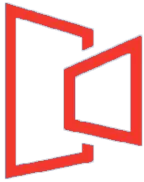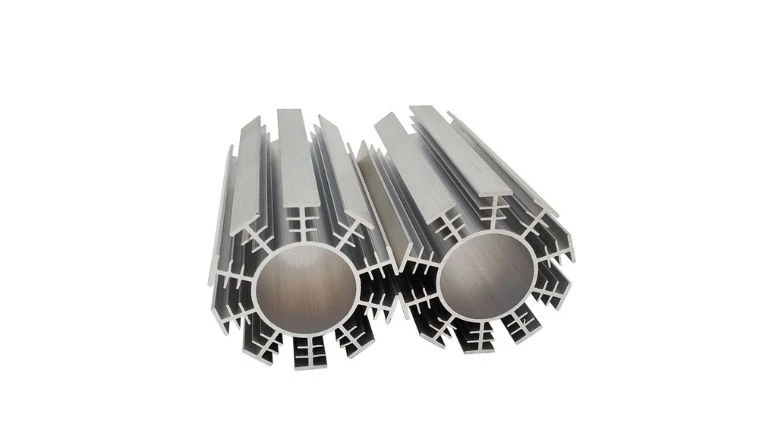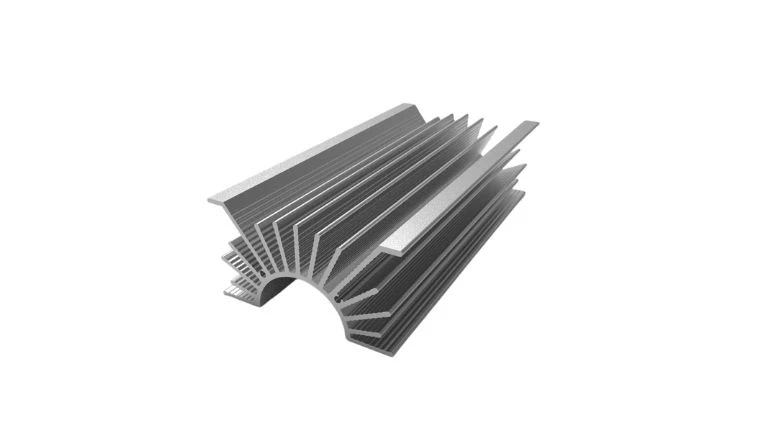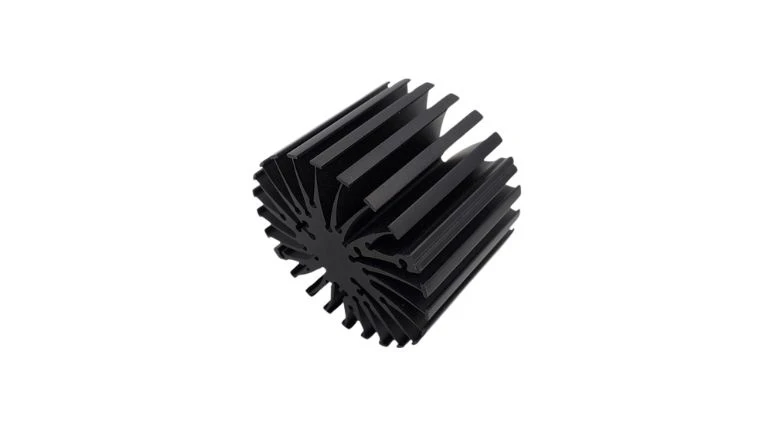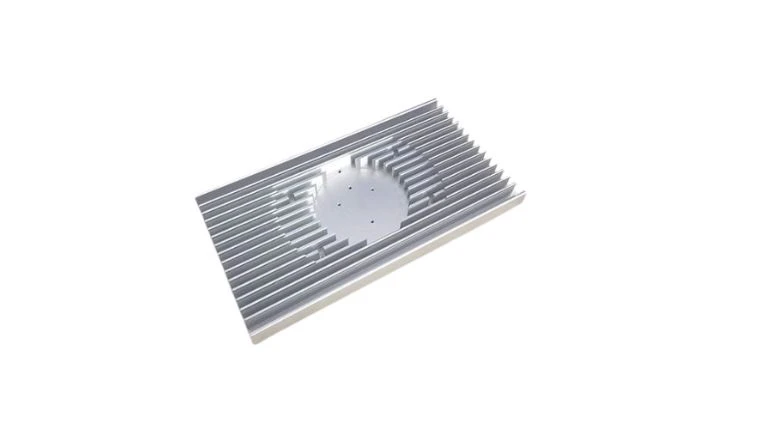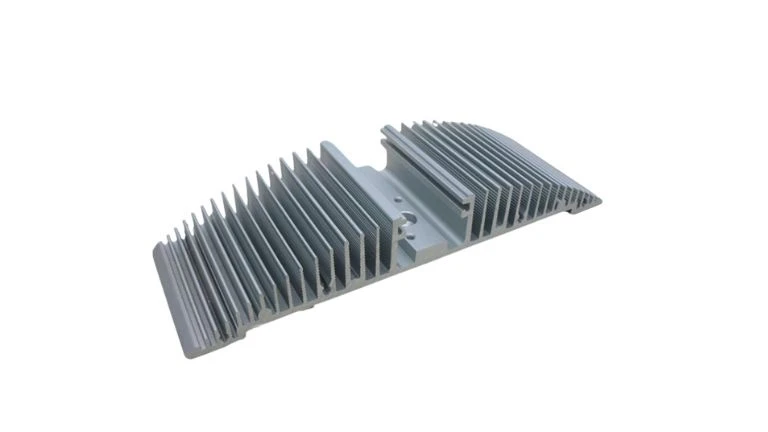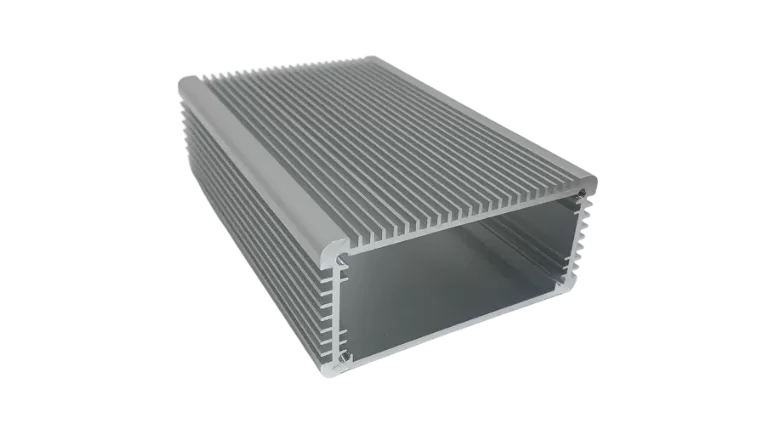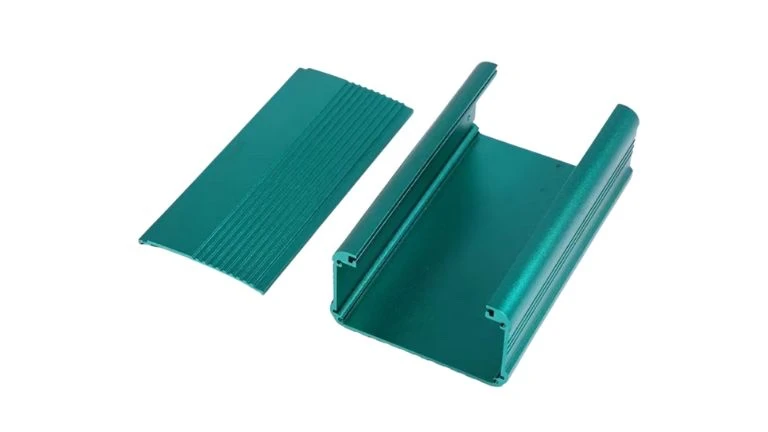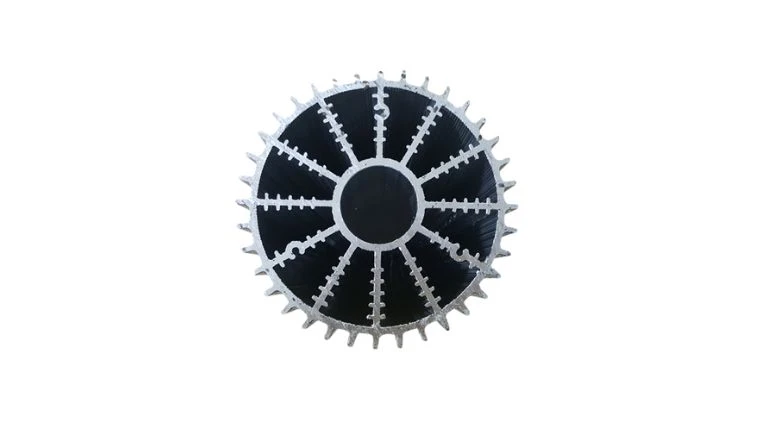Custom Aluminium Heat Sink Extrusions
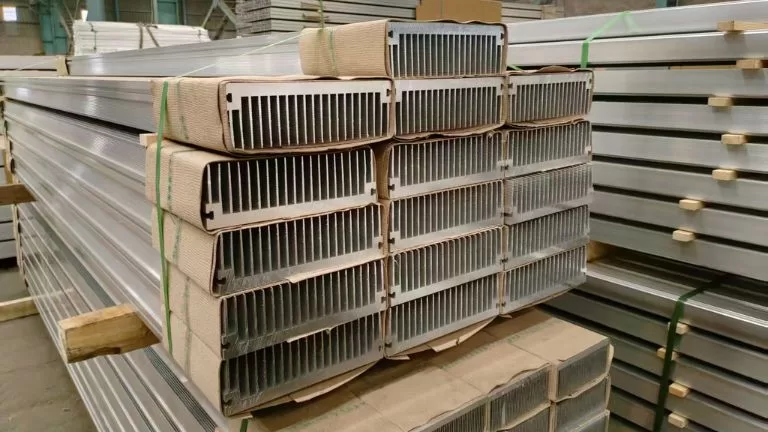
Aluminum Heat Sink Extrusions are structures made from aluminum through the extrusion process. Aluminum is valued for its excellent thermal conductivity and lightweight properties, making aluminum heat sinks widely used in various applications, including electronic devices, LED lighting, and the automotive industry.
- Over 20 years of industry experience ensures the mastery of high-quality aluminum heat sink extrusions.
- An extensive production capacity of 40 extrusion lines allows for the efficient fulfillment of large-scale orders with up to 6,000 tons of processing capability.
- Specialized surface treatments like oxidation, colored anodizing, and powder coating elevate our products, enhancing both performance and aesthetics.
- Advanced in-house machining capabilities enable precision milling, threading, welding, and custom engraving for logos or designs.
Aaluminum Heat Sinks
Aluminium heat sink extrusions, frequently utilized as passive heat sinks, play a crucial role in thermal management across various industries, including electronics, automotive, and manufacturing. These extrusions feature optimized geometries designed to maximize surface area, allowing for efficient heat dissipation from electronic components and machinery, which in turn enhances overall performance and prolongs lifespan. When compared to other materials such as copper, aluminum stands out as a lightweight, cost-effective, and highly conductive option, making it an ideal choice for applications requiring effective heat dissipation solutions.
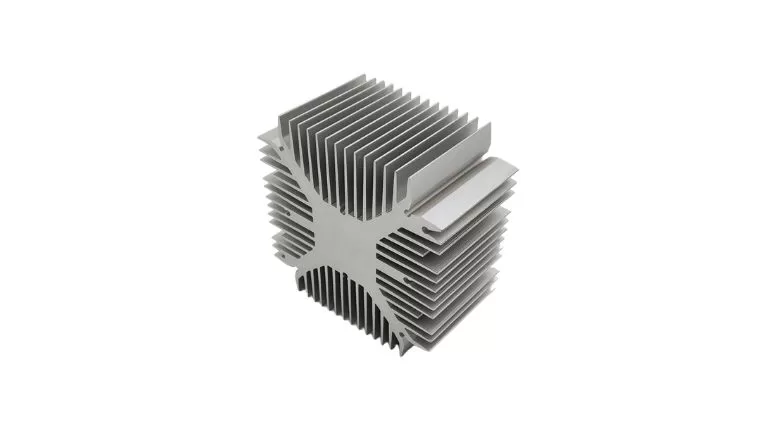
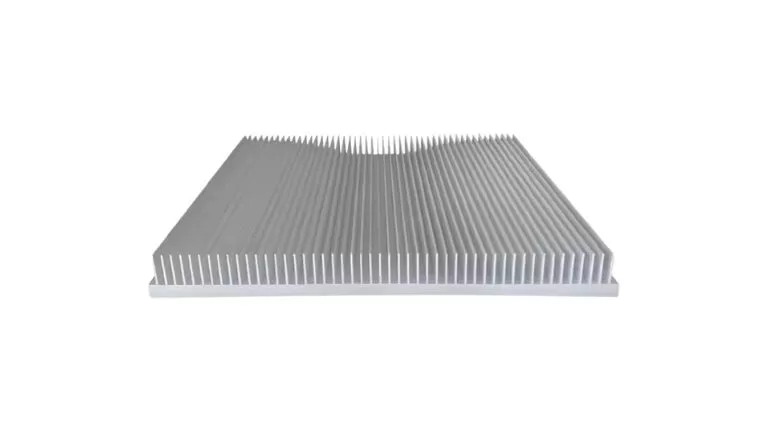
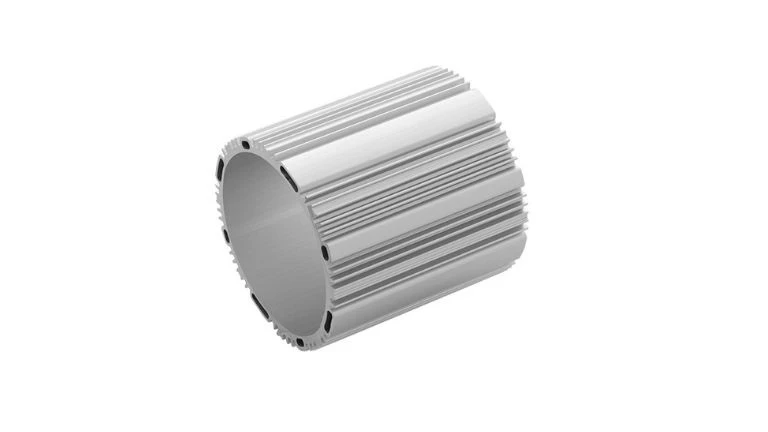

Extrusion Process
HTS-ALU is equipped with 40 extrusion production lines, enabling us to handle large-scale orders with ease. Our largest extrusion machine has a capacity of 6,000 tons, allowing us to manufacture both small and large heat sinks to meet diverse customer needs. This extensive capacity ensures timely delivery and high-quality products for our clients.
Extruded Heat Sink Machine Process
At our factory, we specialize in the machining of extruded aluminum heat sinks, equipped with advanced machinery to enhance the functionality and versatility of our aluminum profiles. We operate two precision cutting machines, along with eight CNC machines, including both 4-axis and 5-axis models, capable of processing lengths up to 7500 mm. Our comprehensive capabilities include precision cutting for exact lengths and clean edges, as well as punching and threading for essential modifications. Slotting is also performed to ensure compatibility with various components. Additionally, our assembly services guarantee that all parts are correctly joined and ready for immediate deployment across a wide range of applications.

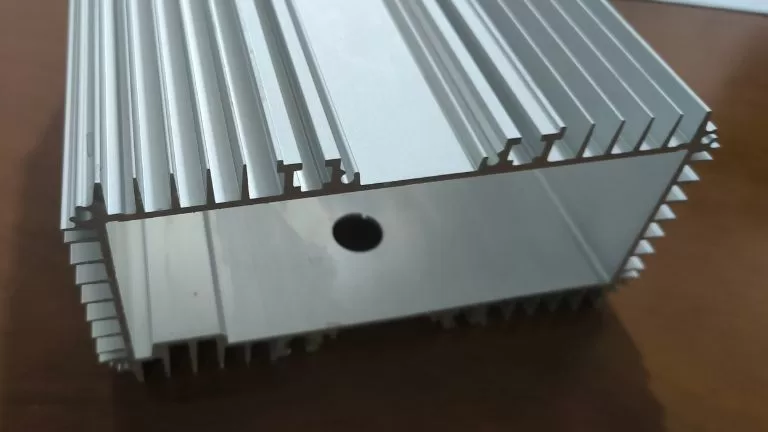
Precision Cutting: We can accurately cut aluminum heat sinks to the exact lengths specified by our customers, ensuring a perfect fit for their applications.
Tapping and Threaded Holes: Our facilities are equipped to create threaded holes, allowing for the easy installation of fasteners in the heat sinks.
Drilling: We offer precise drilling services to create holes for mounting or airflow, tailored to meet specific design requirements.
Milling: Using customer-provided drawings, we can mill the extrusions to achieve the desired complex structures and designs.
Welding: We provide welding services, such as attaching studs or other components to the heat sinks, enhancing their functionality.
Engraving and Logo Application: Custom engraving or logo application is available through laser engraving or silk screening, adding a personalized touch to the products.
Surface Finishes for Aluminum Heatsinks
The surface treatment of aluminum heat sinks is essential for improving their performance and durability. It enhances corrosion resistance, extends product lifespan, and boosts thermal conductivity for better heat dissipation. Surface treatments also improve aesthetics through colored anodizing or painting, reduce friction to minimize wear, and increase adhesion of coatings for greater durability. Additionally, treated aluminum heat sinks can meet industry standards, creating new market opportunities. Overall, effective surface treatment significantly enhances product value and customer satisfaction.
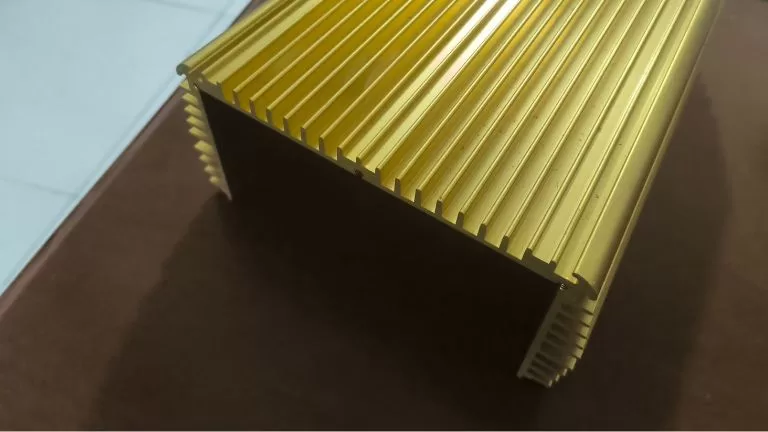
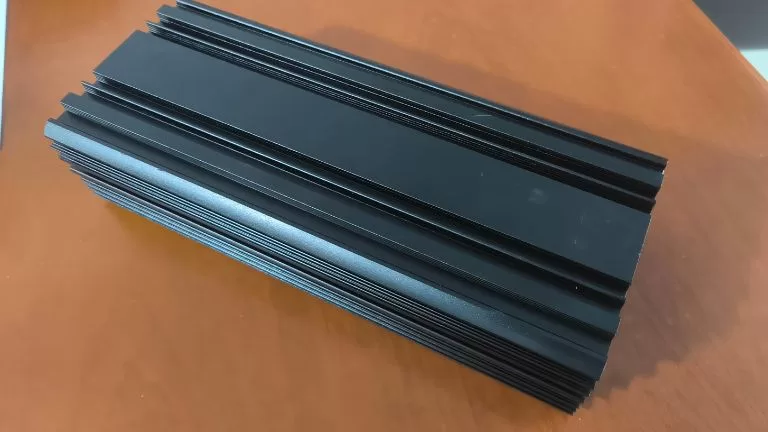
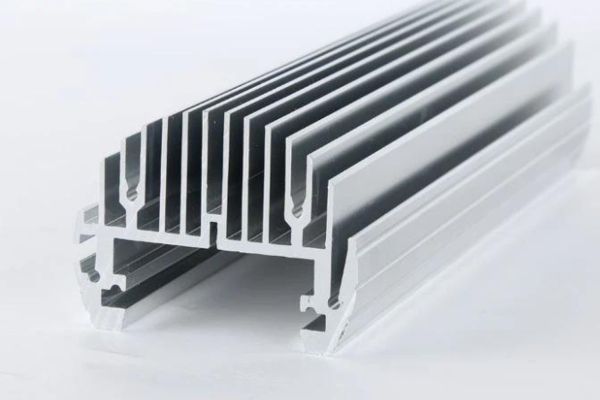
Anodizing
Anodizing creates a durable, corrosion-resistant aluminum oxide layer and can also add color for aesthetic appeal. However, this oxide layer is an insulator, which can significantly reduce the electrical conductivity of the aluminum. The thickness of the anodized layer influences this effect, so thinner anodizing may mitigate conductivity loss compared to thicker coatings.
Powder Coating
Powder coating applies a layer of powder paint to the heat sink, which is then heated to form a protective coating. This method improves corrosion resistance and offers various color options. Spray coating creates a protective layer by spraying a liquid coating, enhancing durability and appearance.
Other Surface Treatments
Chemical plating deposits a film on the aluminum surface to improve conductivity and corrosion resistance, while passivation forms a thin protective film that further enhances corrosion resistance. These surface treatments improve the durability, performance, and aesthetics of aluminum heat sinks, making them suitable for various applications. Choosing the right treatment is essential for the heat sink’s long-term effectiveness.
Our Factory
Our factory is equipped with 40 extrusion production lines to efficiently manufacture aluminum heat sinks. We have one anodizing and electrophoresis line, along with two vertical spraying machines and two horizontal spraying machines for surface treatment. Additionally, we operate two sandblasting machines and six wood grain transfer printing lines, enabling us to provide various aesthetic finishes. To support our production, we also have furnaces for casting aluminum bars, aging furnaces, annealing furnaces, water cooling treatment equipment, and machining equipment, ensuring comprehensive capabilities for high-quality output.
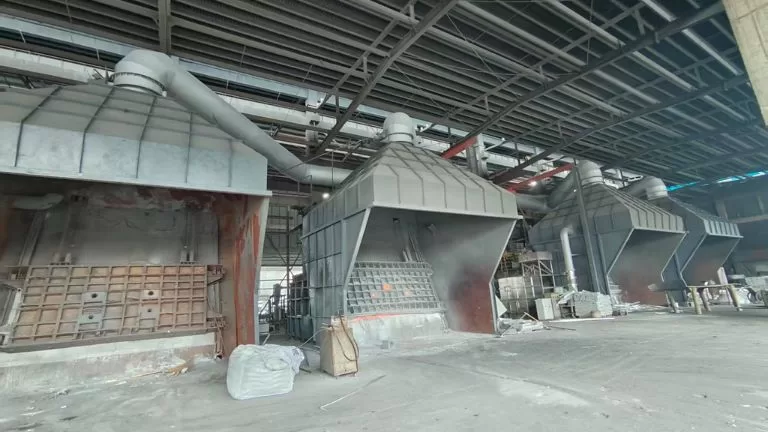
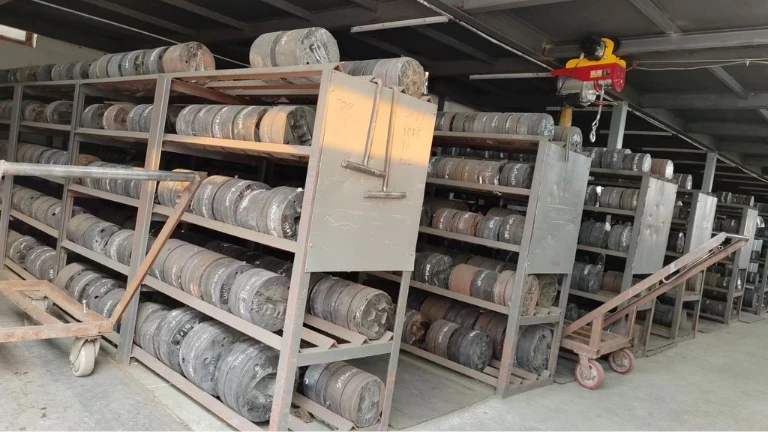
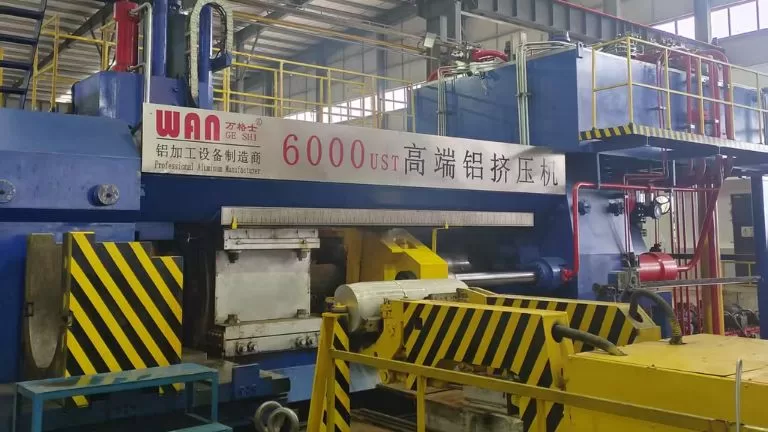
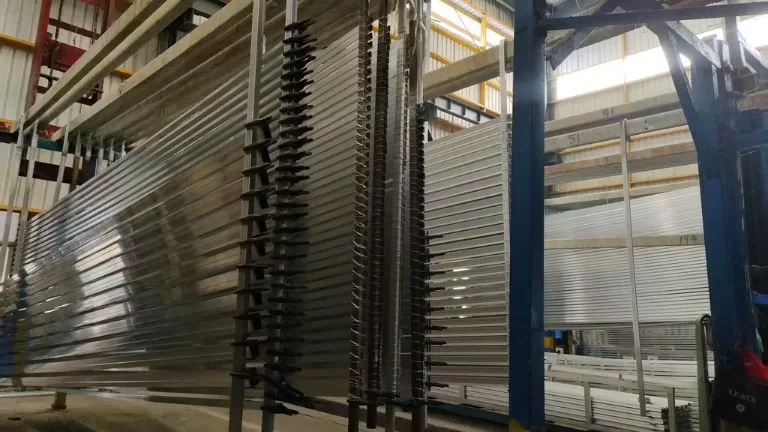
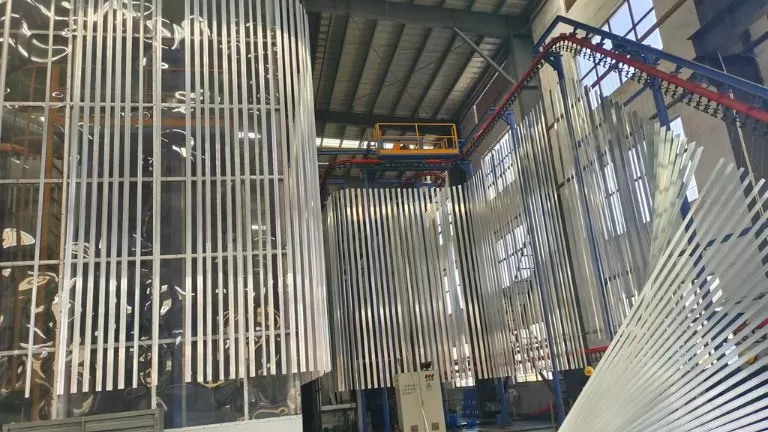


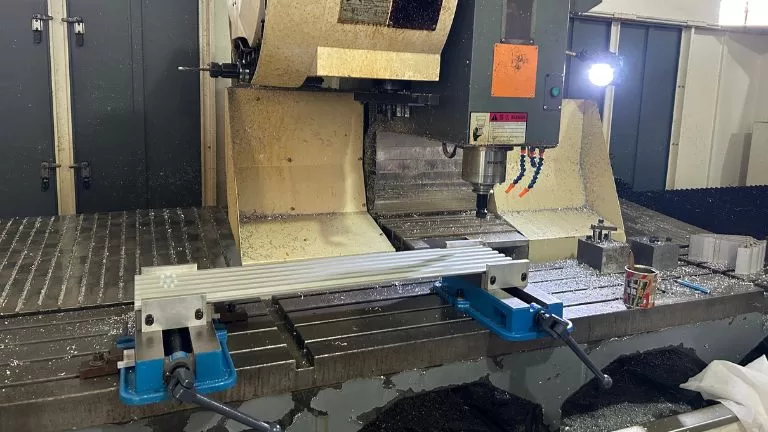
Extruded Aluminum Heatsink Solution
HTS-ALU offers a comprehensive one-stop solution for aluminum heat sinks. We possess the capability to cast aluminum bars and can customize aluminum alloy compositions based on customer specifications. Our experienced team develops molds according to client drawings or samples, ensuring that every product meets the exact requirements.
With 40 extrusion production lines and a capacity exceeding 100,000 tons, we are well-equipped to handle high-volume orders efficiently. Our largest 6,000-ton extrusion machine is capable of manufacturing large heat sinks, providing flexibility for various project sizes.
Additionally, we offer complete surface treatment and machining processes, allowing our customers to receive fully finished heat sink products. This streamlined process ensures that clients can obtain high-quality solutions with minimal lead times.
Aluminum Extruded Heat Sink Applications
Extruded aluminum heat sinks are widely used in various applications to manage and dissipate heat efficiently. They are commonly found in electronics to cool components like CPUs, GPUs, and power modules. In the automotive industry, they help regulate temperatures in electric vehicles and other systems. They are also crucial in LED lighting to extend the lifespan of the bulbs. Additionally, extruded aluminum heat sinks are used in renewable energy systems, such as solar inverters and wind turbines, as well as in industrial machinery to enhance performance and durability.
Aluminium Motor Body
Aluminum extrusions are ideal for motor bodies due to their superior strength-to-weight ratio and excellent thermal conductivity, which are crucial for electric and hybrid vehicles requiring efficient heat dissipation. These extrusions facilitate the creation of complex, precise shapes, optimizing space and enhancing vehicle performance through weight reduction. Additionally, aluminum’s natural corrosion resistance and durability ensure long-term reliability and lower maintenance costs in harsh environments.

Electronics and Computing Heat Sink
Aluminum heat sinks are extensively used in the electronics and computing industry to prevent overheating in devices such as CPUs, GPUs, and power transistors. By efficiently dissipating heat, these extrusions ensure that electronic components operate within safe temperature limits, enhancing performance and preventing premature failure.
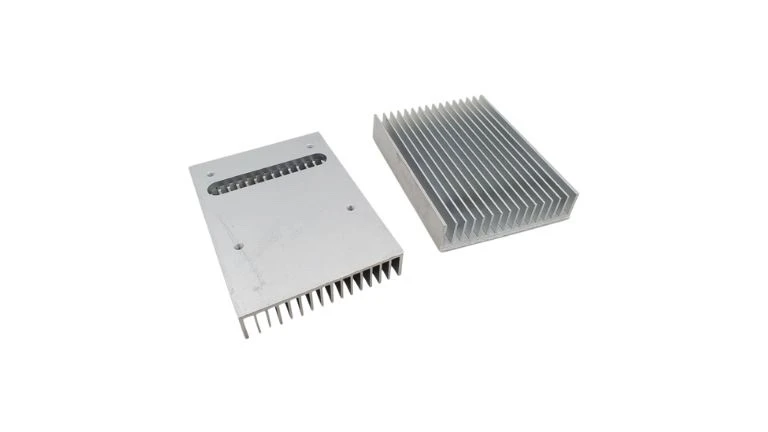
LED Lighting Heat Sink
As LED technology continues to advance, managing heat becomes increasingly important to maintain the efficiency and lifespan of LED lights. Aluminum heat sink extrusions are used in LED lighting fixtures to absorb and dissipate the heat generated by LEDs, thereby preventing overheating and ensuring stable operation.
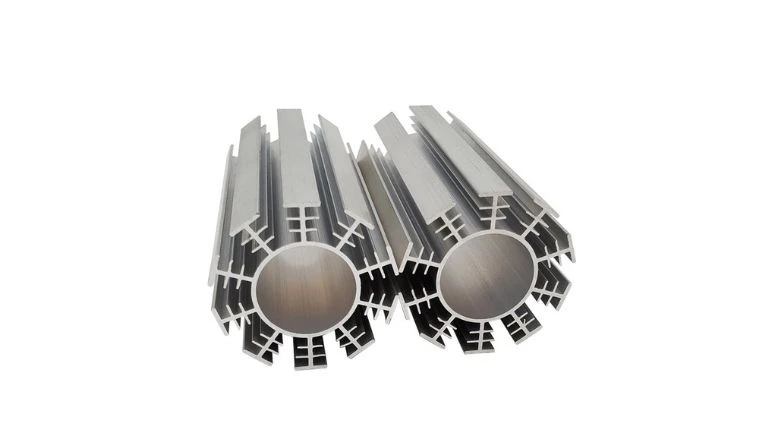
Telecommunications Heat Sink
Telecommunication equipment such as high-frequency servers, routers, and other infrastructure components rely on aluminum heat sinks to manage heat. These devices often operate continuously and generate significant amounts of heat, which if not properly managed, can lead to system failures and reduced efficiency.
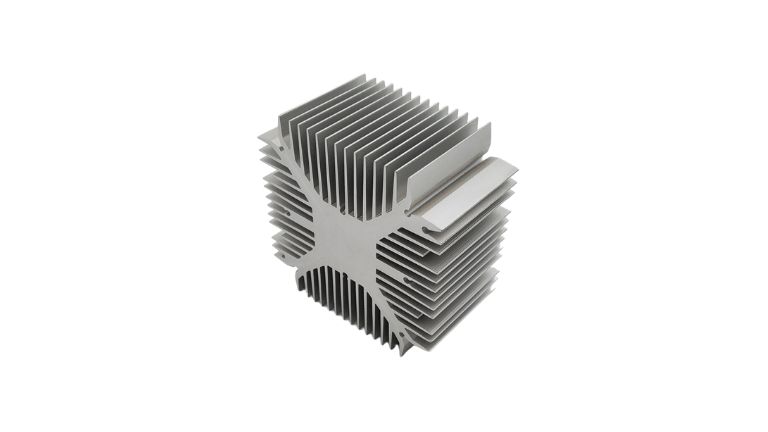
Industrial Machinery Heat Sink
Heat sinks in industrial applications often need to handle extreme conditions and high power devices. Custom-designed extrusions are used to meet specific requirements and ensure machinery operates efficiently and safely.
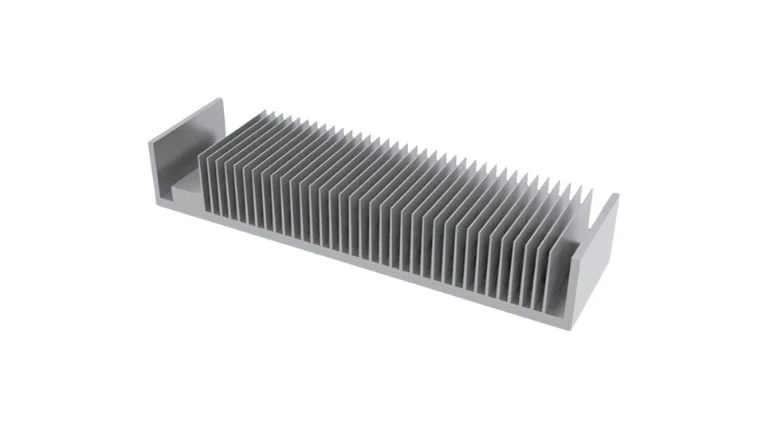
RFQ of Extruded Aluminum Profile
The primary aluminum alloys used for extrusion belong to the 6xxx series, specifically 6061, 6063, 6060,6082 and 6066. These alloys are highly favored due to their excellent extrudability, good mechanical properties, and corrosion resistance.
- 6061: A versatile alloy with higher strength, suitable for structural and transportation applications.
- 6063: Known as the “architectural alloy,” it offers excellent surface finish and is widely used for decorative and structural purposes.
- 6060: Similar to 6063 but with slightly lower strength, ideal for intricate and thin-walled profiles.
- 6066: A high-strength alloy within the 6xxx series, often used in more demanding structural applications.
- 6082: A strong alloy with better mechanical properties compared to 6061 and excellent corrosion resistance, commonly used in high-load structural applications and in marine environments.
The 7xxx series alloys, such as 7075, are used in applications requiring extremely high strength and performance, such as aerospace and high-end engineering projects. However, they have lower corrosion resistance when compared to 6xxx alloys and are therefore less commonly used for general extrusion applications.
While 1xxx, 3xxx, and 5xxx series alloys can be extruded, they are generally used infrequently for extrusion due to their lower strength or other limitations compared to 6xxx and 7xxx alloys. These series are mainly used in specialized applications. Additionally, if extrusion products from these series are requested, higher minimum order quantities (MOQ) are typically required for custom production, as their demand is relatively low.
The heat treatment of aluminum extrusions determines their mechanical properties, strength, and suitability for specific applications. Among the various heat treatment methods, T5, T6, and T66 are the most commonly used. Here’s an in-depth look:
| Heat Treatment State | Cooling Method | Strength | Key Features and Benefits | Applications |
|---|---|---|---|---|
| T5 | Air cooling (fan) | Moderate | Adequate strength, good dimensional stability, used for architectural purposes. | Windows, doors, curtain walls, building structures. |
| T6 | Water quenching (fast) | High | Higher strength and hardness, ideal for industrial and structural uses. | Automotive, aerospace, machinery, transport parts. |
| T66 | Water quenching (fast) | Very high | Optimized mechanical properties for higher strength and performance demands. | Automotive, rail transportation, high-end machinery. |
Other Heat Treatment States
- T4: Solution heat-treated and naturally aged. Used in applications requiring intermediate strength and enhanced formability.
- T7: Overaged for better stress-corrosion resistance, often used for aerospace and marine purposes.
- O (Annealed): Very soft condition suitable for extensive forming or bending requirements.
- F (As-Fabricated): No heat treatment applied, used in non-critical applications with low strength requirements.
Aluminum extrusions undergo various surface treatments to enhance aesthetics, corrosion resistance, and functionality. Here are the common surface treatment methods used in the industry:
Main Surface Treatment Methods
Anodizing (Oxidation)
- Process: A controlled electrochemical process that forms a protective oxide layer on the aluminum surface.
- Features:
- Provides a durable, corrosion-resistant, and environmentally friendly finish.
- Produces a metallic finish with a variety of natural tones (e.g., silver, black, bronze).
- Improves surface hardness and protects against scratching.
- Applications: Architectural frames, decorative profiles, heat sinks.
Electrophoresis Coating (E-Coating)
- Process: After anodizing, the aluminum is coated with paint using an electrochemical process.
- Features:
- Enhances corrosion resistance and offers a smooth, glossy finish.
- Provides more color and texture variation compared to anodizing alone.
- Applications: Furniture profiles, indoor architectural components.
Powder Coating
- Process: Electrostatic application of powder paint, followed by curing under high temperature to form a solid coating.
- Features:
- Wide variety of colors and textures.
- Excellent weather resistance and corrosion protection.
- Cost-effective and highly versatile.
- Applications: Outdoor frames, fences, railings, general industrial use.
PVDF Coating (Polyvinylidene Fluoride)
- Process: A specialized fluoropolymer coating is applied in multiple layers, commonly over a pretreated surface.
- Features:
- Exceptional weather resistance and UV stability.
- Highly durable, resistant to fading, chalking, and chemical damage.
- Ideal for long-term outdoor use.
- Applications: Curtain walls, high-performance architectural facades.
Wood Grain Transfer Printing
- Process: A heat-transfer printing process that applies a wood grain effect onto a pre-coated aluminum surface.
- Features:
- Mimics the appearance of wood while retaining aluminum’s durability.
- Lightweight and weather-resistant alternative to natural wood.
- Applications: Furniture, decorative coverings, outdoor panels.
Film Lamination
- Process: Adhesive application of a protective or decorative film onto the aluminum surface.
- Features:
- Provides a glossy, textured, or patterned finish.
- Often used for applications requiring specific textures like marble or leather effects.
- Applications: Interior decor, windows.
Pre-Treatment Processes
Prior to surface treatment, the aluminum surface can be pre-processed for specific textures or finishes:
Brushing/Polishing
- Removes surface imperfections and creates a smooth, reflective finish.
- Often used for decorative purposes.
Sanding/Grinding
- Produces a matte or satin finish by applying abrasives.
Shot Blasting/Sandblasting
- Sprays abrasives at high velocity to create a textured surface, often used before anodizing for a uniform appearance.
Stretching and Tension Leveling
- Straightens the aluminum profile and improves shape accuracy after extrusion.
Cost and Durability Comparison Table
| Treatment Method | Process Cost | Surface Durability | Weather Resistance | Applications |
|---|---|---|---|---|
| Anodizing (Oxidation) | Medium | Very Durable | High | Architectural frames, industrial parts. |
| Electrophoresis (E-Coating) | Medium-High | Durable | Medium | Furniture, indoor parts, decorative uses. |
| Powder Coating | Medium | Highly Durable | High | Outdoor frames, industrial fixtures. |
| PVDF Coating | High | Extremely Durable | Excellent | Curtain walls, high-end exteriors. |
| Wood Grain Printing | Medium | Moderate (topcoat dependent) | Medium | Decorative panels, furniture. |
| Film Lamination | Low-Medium | Moderate | Low | Indoor decorations, windows. |
| Brushing/Sandblasting (Pre-Treatment) | Low | Not Applicable (Preparation only) | N/A | Preparation for further treatment. |
. Anodizing (Oxidation)
- Common Colors:
Natural silver
Black
Champagne
Light bronze
Dark bronze
Gold
2. Electrophoresis Coating (E-Coating)
- Common Colors:
Black
Champagne
Light bronze
Dark bronze
Custom metallic colors
3. Powder Coating
- Colors:
Can match any color based on the RAL color chart.
Offers textures like matte, gloss, satin, and custom finishes.
4. PVDF Coating (Polyvinylidene Fluoride)
- Colors:
Also customizable using the RAL color chart.
High-end finishes with matte or glossy effects.
5. Wood Grain Transfer Printing
- Colors and Patterns:
Mimics various wood types (e.g., oak, walnut, teak, mahogany).
Custom patterns available based on provided samples.
6. Film Lamination
- Colors and Patterns:
Includes textures like marble, leather, and solid colors.
Custom finishes and patterns based on provided samples.
Pre-Treatment Options (Impact on Final Color)
- Brushing/Polishing: Produces smooth or reflective metallic surfaces.
- Sandblasting: Adds a rough, matte texture before the final surface treatment.
We provide a wide range of machining services for aluminum extrusions to meet specific requirements. These include cutting off/section removal, slotting, drilling holes, tapping threads, bending, and localized stamping to create deformations. For example, we can trim extruded profiles to custom lengths, mill precise grooves, create threaded holes for fasteners, bend profiles into specific shapes, or apply localized stamping to achieve custom forms or deformation.
In addition to these processes, we also offer TIG/MIG welding to join aluminum components for a solid structure. Furthermore, our services include assembly of common accessories, such as brackets, corner connectors, screws, hinges, end caps, and rubber seals, providing complete and ready-to-install profile solutions tailored to your project needs. This ensures that we can handle everything from simple cuts to highly customized fabrication and assembly, all with precision and efficiency.
For custom aluminum extrusion projects, we accept a variety of drawing formats, including CAD files, STEP files, and PDF files. However, for extrusions that require additional machining processes, it’s recommended to provide STEP files, as they ensure precise 3D modeling for machining accuracy.
While PDF files are acceptable, converting them into CAD drawings may result in the loss of certain details, requiring us to manually redraw the design, which could increase lead time. For the fastest and most accurate quotation, we recommend providing CAD files (e.g., DWG/DXF) and STEP files to ensure efficient design evaluation and pricing.
Mold fees are an essential part of the custom aluminum extrusion process. Since every order requires a uniquely designed mold tailored to specific requirements, these molds cannot be used for other products. Therefore, the mold fee is necessary and non-negotiable.
We require 100% upfront payment of the mold fee before mold development begins to ensure timely production. However, as a token of appreciation for your support, we offer a refund of the mold fee or equivalent discounts once the order reaches a certain production volume. Specific policies can be discussed based on your order volume and collaboration details.
Our minimum order quantity (MOQ) varies depending on the size of the product. For smaller-sized products, the MOQ is typically 500kg, while for larger-sized products, it is 2 tons.
We will specify the exact MOQ requirements during the quotation process. If your order quantity does not meet the MOQ, we can still arrange production, but an additional fee will be applied to cover mold preheating and production setup time. Rest assured, this extra fee will be reasonable, and we aim to keep it as minimal as possible to ensure smooth cooperation.
Packaging can be customized according to your needs. Options include using protective film or paper to separate and protect the surface, or foam film for additional surface protection. Products can be palletized or packed into cartons, and the quantity per pallet or carton can be specified by the customer.
The standard packaging involves bundling several pieces together with plastic wrap and then securing them onto pallets. Any packaging requirements beyond the standard will be accommodated, and the associated costs will be clearly provided to the customer.
Mold production typically takes 7 days. After the sample is confirmed, producing a full container load of 26 tons generally requires 14 days for extrusion alone. If surface treatment is required, an additional 3 days will be needed. For machining, extra time will be required depending on the complexity and volume of the machining work. The exact additional time for machining will be determined based on the specific processing requirements.
Aluminum profiles are naturally corrosion-resistant due to the formation of a thin, protective oxide layer when exposed to air or water. This oxide layer is stable and self-repairing, meaning that even if the surface is scratched or cut (such as at exposed ends or during processing), the aluminum will not rust or corrode like iron or steel. Instead, the exposed areas will quickly form a new oxide layer, providing continuous protection against further oxidation.
With proper design, installation, and maintenance, aluminum profiles can last for decades, even in challenging environments. For example, untreated aluminum can easily withstand 20-30 years in outdoor applications, while profiles with surface treatments like anodizing or powder coating can last even longer, often exceeding 50 years. This makes aluminum an excellent choice for applications where durability and long-term performance are essential.
The price of aluminum profiles consists of several components: raw material costs, extrusion processing fees, surface treatment fees, machining costs, and additional packaging fees. Among these, the cost of aluminum as a raw material tends to fluctuate frequently, while other fees remain relatively stable. Due to these fluctuations, our quotations are typically valid for 7 days.
Pricing can be structured in different ways depending on the product and requirements. It can be calculated by weight (e.g., cost per ton), by length (e.g., cost per meter), or by piece (e.g., cost per unit). For products involving extensive machining, such as heat sinks, pricing is generally calculated on a per-piece basis to accurately reflect the additional processing costs. This flexible pricing approach ensures the quote is tailored to the specific needs of the customer.
We can manufacture aluminum profiles in compliance with technical requirements that meet European standards (EN), American standards (ASTM/AA), or other standards as specified by the customer. Custom production is tailored to ensure that the profiles meet the specific standard requirements requested.
Our production equipment is designed for the metric system. If the drawings provided are in the imperial system, we will convert them into metric units for production to ensure accuracy.
It is important to note that while we can machine imperial-threaded holes for fasteners, if you require us to supply matching imperial fasteners, they may not always be available in stock. Custom orders for imperial fasteners typically require a large volume for production. Please consider this when planning your project.
The majority of aluminum profiles we produce are custom-made and do not have existing molds. However, for some standard profiles such as square tubes, round tubes, U-channels, and T-SLOT profiles, we do have existing molds, and in some cases, small quantities in stock.
For certain specialized profiles, like ladder aluminum profiles, we have some molds that may be used across similar designs. For curtain wall and window/door profiles, we have developed a number of molds, though most are tailored to the Chinese domestic market.
Additionally, for furniture-related profiles, such as cabinet handles, cabinet door frames, skirting boards, tile edge trims, wall panel trims, stair anti-slip strips, partition aluminum profiles, corrugated aluminum profile (like long-span profiles), LED light channels, and photovoltaic frame supports, we offer a selection of ready-made designs and some existing molds.
While we have limited stock of standard profiles like square tubes, round tubes, U-channels, and T-SLOT profiles, we recommend contacting our sales team for details on availability and further assistance.
